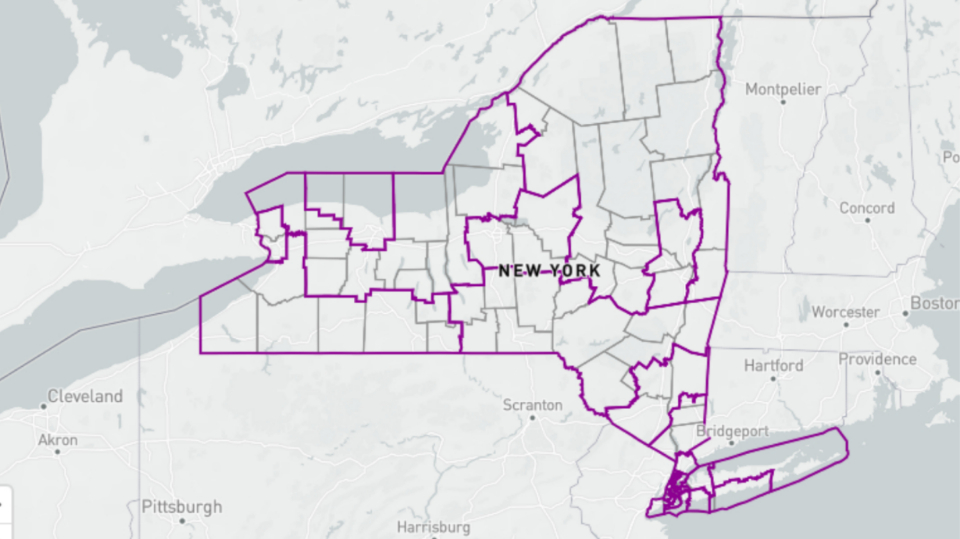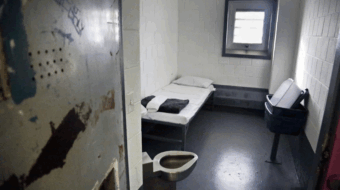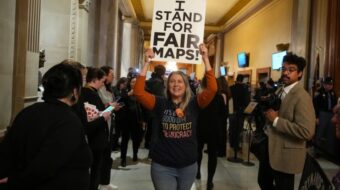
Albert Einstein once said, “If you can’t explain it simply, you don’t understand it well enough.” He was one of the world’s greatest physicists (and a socialist). But he was not a fortune-teller looking at this year’s elections in New York State.
No one has yet voted. Yet already we have changed the rules to remove names from the ballot while in the middle of the game. We have lived through three different maps for both State Senators and U.S. House candidates. And we have returned to multiple primary elections, increasing costs and decreasing turnout. (Concerning redistricting this article deals mainly with congressional redistricting. State Assembly and Senate districts require separate analysis.)
Fluctuating lieutenant governors

In August last year, Attorney General Leticia James issued a report concluding that Gov. Andrew Cuomo sexually harassed nearly a dozen women. He resigned and Lt. Gov. Kathy Hochul became governor. Her pick to fill her old seat, State Sen. Brian Benjamin, D-Dist. 30, was arrested this past April on five counts of bribery and corruption.
Benjamin resigned, but his name was already on the Democratic primary election ballot. Since candidates for governor and lieutenant governor run separately in the primary, this immediately elevated the campaigns of the other two contenders. One is Diana Reyna, a former New York City Council member and former deputy borough president of Brooklyn, who is supporting gubernatorial candidate Rep. Tom Suozzi, D–NY-3. They are campaigning to Hochul’s right.
The other is progressive Ana María Archila. She was the co-executive director of the Center for Popular Democracy and co-founder and co-executive director of Make the Road New York. To Hochul’s left are Archila and gubernatorial candidate Jumaane Williams, New York City’s Public Advocate.
It was unpalatable to Hochul for an opponent’s lieutenant governor choice to win. She arm-twisted the state legislature to change the law on how to remove names from the ballot. Previously, one had to move out of state, run for a different office, or die. Now, one can also be arrested and charged with either state or federal misdemeanors or felonies.
Many legislators were initially hesitant, and a significant number of them voted against it. The Senate vote was 33 to 29 (though the Democrats have a 43 to 20 advantage). The Assembly vote was 82 to 57 (despite the Democrats holding 105 seats to 43 Republicans, one independent, and one vacancy).
Gov. Hochul solved her state problem by adding to a national one. Her replacement is moderate Rep. Antonio Delgado, D–NY-19. Delgado won by flipping a Republican seat in 2018. Now an open seat, without an incumbent, the Democratic Party’s task to maintain control of the House was made one seat more complicated.
Redistricting roller coaster
The state’s misnamed independent redistricting commission failed to agree on a bipartisan plan. (It is not independent—it merely has equal numbers of Republicans and Democrats.) So the lawmakers were tasked with drawing the new maps. Democratic supermajorities in both chambers meant they could help their national party either retain control of the House or mitigate their losses. And they redrew the districts accordingly.
Do even children believe that process can be impartial? Predictably, Republicans sued. The state’s highest court ruled that the new maps unfairly favored the Democrats in State Senate and U.S. House election districts. Challenges to the State Assembly boundaries were filed much later—too late to enact changes, according to the courts.
Before two resignations in May, New York’s House delegation comprised 19 Democrats and 8 Republicans (70 to 30 percent). Losing one seat for the coming decade, the Legislature’s proposed map had 22 likely Democratic seats and 4 likely Republican ones (85 to 15 percent). Blatant gerrymandering, despite a likely outcome much more favorable for the state’s working class, equality measures, voting, and abortion rights, slowing down climate change, education.
A “special master”—Carnegie Mellon University Fellow Jonathan Cervas—was appointed to redraw the district boundaries. Redrawing involves multiple competing directives. Districts cannot discourage competition nor favor particular candidates or parties. They must also “consider the maintenance of cores of existing districts” and “communities of interests.” The boundaries should be relatively compact without violating the 1964 Voting Rights Act.
Even Einstein would have a hard time with that assignment.
The public saw the special master maps May 16 and had until May 20 to submit comments. The proposed new boundaries ended partisan gerrymandering. There were now 15 Democratic-leaning, 3 Republican-leaning, and 8 toss-up House districts. If the parties win what they are supposed to and split the 8 toss-ups, the outcome will be 19 Democratic and 7 Republican members (73 to 27 percent)—nearly identical to the current delegation.
However, the special master maps failed on voting rights and other issues. With the strength of making districts compact, the new House districts clearly diluted Black, Latino, and Asian voters in several newly drawn House districts. There were complaints that some incumbents no longer resided in their districts (though that is not illegal). Furthermore, in a few cases, different incumbents now lived in the same district.
Rep. Hakeem Jeffries, D–NY-8, railed against the degradation of Black and Latino communities, calling it “a sledgehammer to Black districts…enough to make Jim Crow blush.” For example, the Black voting age population (VAP) in NY-5 (Gregory Meeks, D) is currently 45%, the same percent in the Legislature’s 2022 plan, but was only 41% in the new special plan.
For the past decade, Brooklyn’s Sunset Park neighborhood, with a large Latino and Asian population, had been divided between NY-7 (Nydia Veláquez, D) and NY-10 (Jerry Nadler, D). The original special master map united it but placed nearly all of it inside the much more conservative and mostly white-populated NY-11 (Nicole Malliotakis, R). This, according to Susan Lerner of Common Cause and other critics, “significantly diminished” Asian and Latino voting strength.
Manhattan’s abutting Chinatown and Lower East Side areas, also with significant Asian and Latino populations, could logically be united with Sunset Park. Instead, the three neighborhoods were fractured into the proposed versions of three different districts: NY-9 (Yvette Clarke, D), NY-10 (Nadler), and NY-11 (Malliotakis).
In NY-16 (Jamaal Bowman, D), the Black VAP is currently 30%. In the Legislature’s plan, it was 29%, but in the special master’s proposal, it fell back to 21%. The white VAP increased from 38% in the Legislature’s plan to the special master’s proposed 42%. These slight differences often determine outcomes.
Representatives Nadler and Carolyn Maloney, D–NY-12, would both live in the special master’s District 12. Nadler’s current district, probably the least compact in the state, was radically redrawn, and he lives nowhere near it.
Sean Patrick Maloney, the first openly gay House member from New York, saw his NY-18 seat add much territory from the current NY-19 (vacated by Delgado). Mr. Maloney, head of the Democratic Congressional Campaign Committee, decided to run instead in NY-17, which had gained much of his NY-18 turf. His decision centered on his residence, which now fell in NY-17.
But NY-17 is represented by Mondaire Jones, a member of the Black Caucus and the first openly gay African American member of the House. A Sean Patrick Maloney victory would decrease the size of the Black Caucus, and for that decision, Maloney was properly castigated.
Sochie Nnaemeka, director of the New York Working Families Party, quipped, “For the head of the DCCC, whose role is to lead electoral strategy that creates an equitable and representative Democratic Party, to position himself at the expense of his colleagues—in particular … Black men—seems deeply cynical, unstrategic, and self-serving.”
Representatives Paul Tonko, D–NY-20, and Elise Stefanik, R–NY-21, were paired in the proposed new District 20. Self-described independent and conservative Democrat Brian Higgins (NY-26) and Republican Chris Jacobs (NY-27) both would reside in the new District 23.
Final map and candidate musical chairs
On May 20, the special master made adjustments based on the public criticisms, and the Court approved the districts early the next day. There will be no more changes for congressional and State Senate districts.
The two congressional districts falling completely in Long Island (Lee Zeldin, R–NY-1, and Andrew Garbarino, R–NY-2) were clearly gerrymandered by the Legislature. The special master’s draft reshaped these districts by north and south, but that divided the mostly Black Hempstead in Nassau County. The final plan corrects that error and compactly orients the two districts east and west.
Because he is running for governor, Suozzi must vacate his NY-3 seat. Though the district presently contains a small section of Queens, it has been primarily a Long Island district with sections of both of the island’s counties. The Legislature got an A in creative drawing by heading north and adding strips of the Bronx and Westchester counties. It was laughable to hear its “New York Sound” description.
The final version of NY-3 excludes those Bronx and Westchester county additions. Indeed, none of Suffolk County is included. It is now a Nassau County district, with a small bit of Queens. Under the Legislature’s map, the Democratic Party primary was crowded, with progressives split between State Sen. Alessandra Biaggi and Melanie D’Arrigo, a long-time health care advocate.
Under the final map, Biaggi has decided on a progressive challenge to Mr. Maloney in NY-17. The Working Families Party (previously not involved) has endorsed D’Arrigo, now the sole remaining progressive.
The new NY-8 (Jeffries) reunites Brooklyn’s Bedford-Stuyvesant. That positive created a new negative: the new NY-11 (Malliotakis) gained Brooklyn’s Bensonhurst, and thus is redder than it was going to be. Trumpster Malliotakis voted against the certification of Arizona’s and Pennsylvania’s electoral votes and against the establishment of the Jan. 6 Commission.
Jones, the NY-17 incumbent, has instead decided to run in the now open NY-10, Nadler’s old district but now looking nothing like it. Sunset Park and Chinatown are now both inside it. With its new boundaries, some candidates dropped out and the list of “interested” contenders seems to change daily. Besides Jones, the most prominent names are (alphabetically) former Mayor Bill de Blasio, State Assemblymember Yuh-Line Niou (Dist. 65), and City Council member Carlina Rivera (Dist. 2), all of whom have been endorsed by unions and progressive organizations in the past.
Nadler is vacating his old seat and will instead run against Carolyn Maloney in the new NY-12. Doubtlessly too-early polling has Ms. Maloney ahead of Nadler, 31 to 21 percent, with 36 percent undecided. Ignoring the critics, Sean Patrick Maloney will still run in the new NY-17. State Sen. Biaggi is clearly a long shot but perhaps her candidacy can at least move Mr. Maloney leftwards.
Saratoga Springs, a relatively conservative part of the Capital Region of Albany, is currently included in NY-20 (Paul Tonko, D). Though the Legislature’s map maintained this, the special master map moved it to NY-21 (Elise Stefanik, R). In the end, the whole of Saratoga County is inside NY-20. Though not specifically saying “replacement theory,” Stefanik has run ads under its spell. She voted against accepting Pennsylvania’s electoral vote and creating the Jan. 6 commission.
A return to multiple primaries
At first, the idea was that candidates would have to gather new signatures for the new districts. That would have required a later primary. So a separate primary for State Senate and U.S. House seats was set. Later on, the signatures for the districts that were faultily drawn were deemed valid for the newly drawn districts via administrative measure.
However, the separate primary date stands. So, we have returned to multiple primaries.
For the 2012 federal primaries, New York was sued to move the date from September to instead June because the later date did not give military and overseas voters enough time to receive absentee ballots for November general elections. Democratic state legislators favored moving the state primary date to June, but Republicans successfully opposed it.
Thus, U.S. Senate and House primaries were in June, and all state office primaries were in September. Except during presidential election years, when the state had a third primary!
Local boards of elections were peeved at the extra cost. Cumulatively, a full statewide primary election can cost $30 million. Since the burden was on the local boards, the state had to assist. Election law experts argued that voter interest was diminished, too. After Democrats won super majorities in both chambers of the State Legislature, the federal and state primaries were re-united for the 2020 election year.
The reversion to two different primaries is a terrible step backward after only one sensible election season. This time, it is even more confusing, since different federal and state primaries fall on each of the two dates. The League of Women Voters has filed a suit to combine the two primary dates, but many experts say that is doomed because of the time constraints.
On June 28, there will be primary elections for the seat of Sen. Chuck Schumer (D), governor, lieutenant governor, and all 150 State Assembly seats. (Primaries for the two other statewide offices, attorney general and comptroller, are canceled since neither major party had more than one valid candidate.) On August 23, there will be primaries for the 26 U.S. House and 63 State Senate seats.
The state will have to financially rescue local boards of election. Since billionaires and corporations are not taxed what they should be, the working class and all working people will be stuck with most of the tab.

Final comments
Much of the ire was directed at State Supreme Court Judge Patrick McAllister, a Republican from Steuben County, who originally ruled the Legislature’s maps unconstitutional. This ruling was upheld by the state’s appellate court and the Democratic-heavy Court of Appeal, the state’s highest court. So Democratic judges agreed with the Republicans.
Justice would be blind to not concur, given the advantage the state’s lawmakers gave to likely- and leaning-Democratic redistricting. No question that the Legislature’s maps would have resulted in elected officials more favorable to advancing the interests of the multi-racial and multi-national working class and its democratic allies. Protecting voting, civil, and abortion rights, fighting climate change, advancing union protections, and increasing funding for education: All of these are supported by many or most Democrats and by practically no Republicans. The evidence is overwhelming.
Other states, with Republican-dominated legislatures, are continuing their gerrymandering wars against Black, Latino, and Asian voters as well as white members of the working class, regardless of their level of awareness. Sometimes Republican judges allow it. Sometimes, disputes are so purposefully dragged out, that elections happen under illegally drawn boundaries.
But neither example of gerrymandering is democratic. The core problem is that in far too many states, current lawmakers redraw their own districts. Truly independent commissions without looming vetoes by either governors or legislators are the only way to have fair redistricting. How to get the current mess corrected is a major puzzle.
An unnamed Democratic strategist aptly summed up the New York problem to the New Republic: “Democrats probably did overreach. But in this environment, you’re either matching your opponent’s maximalist approach here, or you’re essentially unilaterally disarming. So in this case, Democrats went for a maximalist approach…and they’re now getting a haircut.”
The maps can be found here. Viewers can switch between Congress, Assembly, and State Senate boundaries. The drop-down list “Select a plan from the list:” shows the Legislature’s boundaries (“RULED UNCONSTITUTIONAL BY COURT”), the Special Master draft, and the Special Master final, as well as many other public proposals. Demographic data as well as the Biden-Trump voting figures are provided for each district of each plan. The current boundaries can also be viewed.










